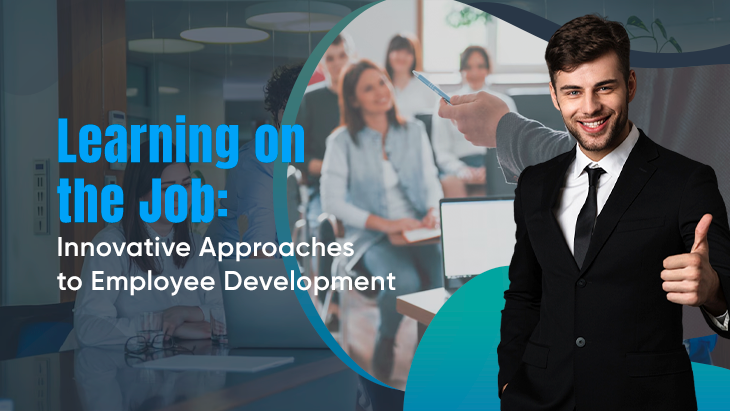The ability to learn and adapt quickly to today’s rapidly changing business environment is critical for employees and organizations. Gone are the days when a degree or higher education could get one into all jobs. Nowadays, continuous learning and professional development are essential to keep up with the latest industry trends and innovations in Mentutor. This shift led to the concept of "on-the-job learning," a dynamic approach to professional development that emphasizes real-time, experiential learning. This article explores alternative ways of learning to work in the workplace and how organizations can use it to better develop their employees.
The Importance of on-the-job Learning
On-the-job learning is a powerful strategy for professional development because it incorporates learning into a natural working environment. In this way, employees can acquire new skills, knowledge, and skills while carrying out their daily tasks. Workplace learning is beneficial for several reasons:
Real-World Application: Employees immediately learn skills relevant to their jobs, leading to deeper understanding and better retention of information.
Increased engagement: Learning is more meaningful when employees can see the direct impact of their new knowledge on their work, making them more engaged and motivated.
Cost-effectiveness: Organizations save on training costs and time by integrating learning into performance, resulting in better utilization of resources.
Adaptability: Employees who learn on the job are better prepared to adapt to changes in their role or organisation, making them more valuable in a fast-paced environment.
Innovative Approaches to On-the-Job Learning
To implement on-the-job learning effectively, organisations need to adopt innovative approaches that go beyond traditional training methods. Here are some practical ways:
Microlearning: Microlearning allows employees to learn quickly and instantly by breaking down information into small, digestible chunks. This approach is ideal for modern workers who often struggle with information overload and short focus times. Microlearning can be delivered through short videos, infographics, quizzes, or short presentations, allowing employees to learn at their own pace and time.
Example: The sales team can use microlearning modules to quickly learn new features and benefits, enabling them to use this knowledge in their next customer interaction.
Counselling and peer tutoring
Mentorship and Peer Learning: Mentoring programs pair less experienced professionals with experienced professionals who can provide guidance, support, and insight. On the other hand, peer learning encourages employees to learn from each other by sharing their knowledge and experience. Both approaches foster a culture of collaboration and continuous learning within the organisation.
Example: A new project manager can be paired with a senior project manager to mentor and learn project management's nuances while tackling real projects. Similarly, team members can conduct regular knowledge sharing to discuss lessons learned from recent projects.
Job Rotation and Cross-Training: Job rotation involves moving employees through roles or departments and exposing them to different aspects of the job. Meanwhile, cross-training teaches employees the skills they need for different jobs in the organisation. Both strategies give employees a broader view of the company and help them develop their diverse skills.
Example: A marketing professional may spend months working with the sales team to understand how different marketing strategies affect sales, resulting in more coordinated and effective campaigns in the future.
Simulations and Role-Playing: The concepts and role-play simulate real-world scenarios that employees may encounter in their roles. This hands-on approach allows employees to practice their skills in a safe environment where they can make mistakes and learn without real-world consequences.
Example: Customer service representatives may participate in practical roles where they deal with complex customer interactions, allowing them to develop and resolve their problem-solving and communication skills.
Just-in-time instruction: Just-in-time learning provides employees with the information and resources they need just when they need them. This approach is particularly effective in fast-paced environments where employees must make quick changes to equipment, technology, or other procedures.
Example: An IT engineer may receive a troubleshooting guide or video tutorial on a new piece of software before they need to apply that knowledge on the job.
Digital Curriculum: The rise of digital learning platforms has changed how employees learn on the job. These sessions will offer resources, including e-learning courses, webinars, and interactive modules that employees can use to develop their skills.
Example: A company might use an online learning management system (LMS) to deliver courses on a variety of topics, from technology skills to leadership development, and allow employees to pursue learning opportunities that align with their career goals.
Work-based learning: Work-based learning involves placing employees in real-world tasks that require them to learn new skills or apply existing skills in new ways. This approach is particularly effective in developing problem-solving skills and encouraging innovation.
Example: A software development team’s job might be to develop a new application from scratch, which requires learning about new programming languages, frameworks, or tools as they go.
Playing the game: Gamification adds game-like features to the learning process, such as points, badges, and leaderboards, to make it more engaging and fun. This approach can motivate employees to participate in learning activities and achieve their development goals.
Example: The sales team could participate in a game-based training program where they would earn points by completing modules on communication skills, with top performers receiving recognition or awards.
Overcoming Challenges in On-the-Job Learning
While learning in the workplace brings many benefits, it is not without its challenges. Some common obstacles are:
Lack of time: Employees often struggle to find time to study in their busy schedules. To address this, organisations need to integrate learning into everyday business and promote a culture that values continuous improvement.
Resistance to change: Employees may be resistant to new ways of learning or unwilling to step out of their comfort zone. To overcome this, organisations need to provide support and encouragement, highlighting the benefits of learning for personal and professional development.
Measuring effectiveness: Measuring learning effectiveness in the workplace can be difficult, especially when it comes to intangible skills like problem solving or creativity. Organisations should establish clear goals and metrics for learning programs and regularly review their impact on employee performance and engagement.
Fostering a Culture of Continuous Learning
For workplace learning to be truly effective, it must be embedded in the organisational culture. Here are some ways to encourage an ongoing learning culture:
Leadership Support: Leadership plays an important role in promoting a learning culture. They should lead by example, actively participate in learning activities, and encourage their teams to do the same.
Recognition and reward: Recognizing and rewarding employees who demonstrate a commitment to learning can motivate others to follow suit. This can be achieved through formal recognition programs, promotions, or various other incentives.
Creating comfortable spaces for learning: Employees need to feel comfortable taking risks and making mistakes as part of the learning process. Organisations can create safe spaces for learning by encouraging a growth mindset and emphasising that mistakes are opportunities for improvement.
Provision of resources and support: Organizations should provide employees with the resources and support they need to pursue learning opportunities, whether through access to digital learning options, mentoring programs, or self-directed study periods.
Conclusion:
On-the-job learning is a powerful method for professional development that matches learning and real-world experience with the needs of the organization. By developing new strategies, fostering a culture of continuous learning, and nurturing mentoring programs, organizations can provide their employees with the skills, knowledge and guidance they need to succeed in today’s workplace that is in the meat.






Leave a reply